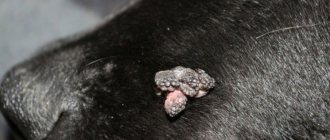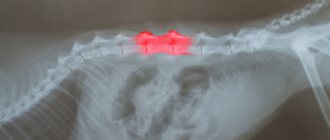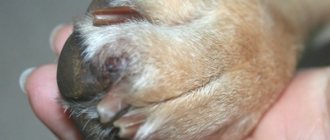Flea classification
Today there are more than two thousand species of fleas. It is almost impossible to distinguish them from each other without special equipment and without sufficient knowledge. However, without going into scientific terminology, they can be classified as follows:
- canine;
- felines;
- human;
- rat;
- chicken
Prevention of infection
Use collars as a preventative measure after treatment with drops and sprays, but only after two to three weeks. The duration of action of the active substance is from 2 to 7 months. Cost from 80 rub. up to 1.5 thousand rubles To prevent infection, place branches of wormwood, lemon balm, lavender around the house, fill the litter with sawdust from coniferous trees - pine, juniper, spruce. Be sure to give your dog an anti-helminth medication after removing fleas to eliminate the risk of infection. After all, fleas are active carriers of tapeworms and other parasites. Don't forget that you too have been in contact with an infected animal. Take care of prevention for yourself and your loved ones.
Video
What do fleas look like on dogs? (photo)
The flea's body has a laterally compressed shape and is covered with scales, bristles and spines. In length it reaches from one to five millimeters, although there are especially twice as many. The mouthparts are piercing-sucking type. Fleas do not have wings, which gives them additional maneuverability in the thick fur of animals. The long, strong limbs on the abdomen allow them to move quickly. The photo shows what fleas look like on a dog under a microscope and in real size.
Description of the parasite and features of its existence
Dog fleas are small black insects whose body is flattened on both sides and reaches sizes up to 4 mm in length. They have a hard shell, a yellow belly and long legs that point backward and are covered with bristles. The structure of the flea's body allows it to move through the thick fur of animals, as well as jump over long distances. These parasites reproduce by laying larvae on the skin and fur of the animal, and their life expectancy is at least 3 years.
The main danger that befalls an affected dog is the flea’s ability to bite through the animal’s skin, as a result of which the parasite’s saliva penetrates the wound and causes the following problems:
- Severe itching at the site of the bite, redness of the skin;
- The appearance of scratching at the bite sites with the further development of skin diseases;
- Increased hair loss;
- Viral diseases;
- Infection with worms;
- Getting into the wounds bacteria that cause allergic reactions;
- Development of anemia, causing death.
The parasite, transmitted from a sick dog to a healthy one, tends to multiply quickly and feed on the dog’s blood. Most often, an increase in the number of fleas is observed in the spring and autumn seasons. Since these parasites pose a danger to animals and multiply very quickly, every owner should know what fleas look like on dogs and how to remove fleas from a dog.
Peculiarities of breeding dog fleas
The parasite multiplies at an incredible speed, but prefers to do this not on the animal’s body, but in secluded places in the external environment. On carpets, in cracks behind baseboards or in fallen leaves. Once every few days, the female lays a large number of eggs from which larvae emerge, which outwardly resemble small caterpillars covered with a dense protective shell. They feed on organic waste and, after several molting cycles, transform into a sexually mature individual awaiting a new victim.
The life cycle of a flea is divided into four stages
The life cycle of a flea is divided into four stages:
1. To mate and lay eggs, an adult female flea needs blood, and she attacks the most suitable host - your animal. After a 23-day feeding period, the adult female flea begins to lay eggs. Fleas are extremely prolific, with an adult female laying up to 50 eggs a day! To the naked eye, flea eggs look like grains of salt. A fertilized female throws out eggs with force, usually in portions of several pieces so that they do not remain on the animal’s fur, but fall to the ground or a place that it constantly visits.
2. The eggs hatch into legless larvae. Using a special “egg tooth”, they seem to cut the shell of the egg in order to get out. The larvae feed on waste products (semi-digested blood) of adult fleas and various decaying organic debris for 4-8 days.
3. The larva spins a thick cocoon, which provides ideal protection from environmental factors and insecticides.
4. The pupa, while in the cocoon, will develop into an adult insect, which will not come out until it senses the proximity of the “master”. Thus, the duration of the pupal stage is several days or months, depending on environmental conditions. The adult is born in response to carbon dioxide, heat and vibrations created by animals and people. Having emerged from the cocoon, she is ready to begin the life cycle again and go through it in three weeks.
Where do dogs get fleas?
Where can a dog pick up fleas and where do they come from? Anywhere, in fact. Fleas can live both outdoors and indoors, in basements. In the grass, in fallen leaves and even on bare ground. The risk of infection is always present, whether the dog is walked in the yard of a house, in specialized areas or in a dense forest. Even a dog that is not outdoors can be infected with parasites from other pets or neighbors. Fleas easily migrate from the entrance to the apartment through the open front door.
Parasites are incredibly jumpy, so even if you don’t let your pet get too close to other four-legged animals, you can’t be completely sure of its safety.
Many owners are very surprised how their exclusively domestic pet was able to “catch” parasites? It's very simple; insects and their larvae can be carried on clothes or the soles of shoes. They can enter the house even through open windows on the first floors.
Traditional methods of eliminating fleas
In this segment you can find both the safest methods of eliminating parasites and not so safe ones:
- Combing insects using a fine-toothed comb is the most harmless method for the animal and the most labor-intensive for the owner; one procedure cannot be done.
- Washing your pet with tar soap - this method can replace the use of special shampoos. But with frequent use it can lead to dry skin.
- Use of wormwood - use a decoction of the herb to wash the floor and other surfaces, lay out linen bags with dried wormwood. It is rubbed into the dog's fur. Tansy can be used for the same purposes.
- If the dog lives in a booth, then it is better to use sawdust as bedding.
- Celandine - a plant infused with vodka is used as drops on the withers, but no more than three drops, since celandine is very toxic.
- Garlic is a powerful antiparasitic that eliminates not only fleas, but also worms and other parasites. Chopped garlic, poured with boiling water and strained, is used to treat the coat, but very carefully so that the dog cannot lick it. Garlic can be added in small quantities to your pet's food.
Signs of fleas in a dog
The main signs of a dog being infected with fleas are:
- restless behavior and aggressiveness;
- constant scratching;
- increased shedding and the appearance of bald spots;
- wounds, sores and redness on the skin.
If symptoms are detected, it is necessary to examine the dog's coat. Pay special attention to the places on the withers, belly and behind the ears. Small brown insects, white eggs or tiny dark balls of excrement are fairly easy to spot.
Symptoms indicating a dog infection
In order to start treatment on time and get rid of the “infection” you have caught, you need to know how to understand that a dog has fleas. Regular inspection and combing of the animal's fur is your reliable assistant. Run a comb or hand against the fur; the white eggs of parasites are visible to the naked eye. You may also notice dark brown grains - this is insect waste.
When fleas have multiplied sufficiently on the animal's body, they become visible. Every dog breeder should know what fleas look like on a dog. These are agile brown insects that quickly hide in the undercoat. Parasites are afraid of water, so they can be easily seen while bathing a dog.
In addition to a visual examination of the pet, the presence of “bloodsuckers” is indicated by the following symptoms:
- The dog itches and does it continuously.
- The animal suddenly jumps up and tries to bite itself.
- Red spots of unknown etiology appear on the dog's skin.
- Bald patches, sores and scratches form on the dog's body.
- The animal whines pitifully for some unknown reason.
- The dog begins to shed prematurely.
- The pet becomes restless and irritable, loses appetite, and suffers from insomnia.
- A sharp decrease in the animal’s weight with proper feeding.
Since ectoparasites are carriers of other serious diseases, over time, gastrointestinal disorders, discoloration of mucous surfaces, and hyperthermia are added to the main symptoms.
As soon as an animal exhibits the above signs, it must be immediately taken to a veterinarian for an accurate diagnosis and treatment. Delay in this matter is unacceptable.
- Domestic iguana
- How much does a raccoon cost?
- Interesting facts about cats
- Cute dog breeds
- The richest animals
- Cat claw attachments
Why are dog fleas dangerous?
Why are fleas dangerous for dogs? They cause discomfort to the pet and can serve as carriers of dangerous infections and diseases, such as plague, typhoid, encephalitis, as well as worm and salmonella eggs.
Many dog breeders believe that fleas are not dangerous to people and live exclusively on animals, while others fear that fleas from a dog can pass to humans. This is not entirely true. The parasite is not able to live permanently on humans, but it can bite. The consequences of a dog flea bite on a person can be serious if the flea is infected. In addition, a severe allergic reaction may occur.
What danger does such a neighborhood pose to a dog?
Flea bites are not only a temporary inconvenience, consisting of skin irritation and constant itching.
A flea attack can cause a number of serious complications:
- Massive attacks by a large population of fleas don't just irritate your dog - they literally drive him crazy. Wounds on flea-damaged skin that do not heal due to scratching can easily be infected by microbes from the external environment. In advanced cases, hair loss and even the appearance of purulent foci may occur.
- Often, as a result of an allergy to flea saliva, an animal develops dermatitis and other skin lesions. This is accompanied by the appearance of edema, eczema and urticaria. The substances contained in the saliva of fleas are very active, so the danger of allergic reactions should not be underestimated, especially if treatment is delayed.
- Fleas often carry pathogens of various diseases. Usually only the plague is remembered, but the actual list of diseases that can be transmitted to flea owners is very long. For dogs, the most dangerous are rickettsiosis and endocarditis. Some diseases can be transmitted from fleas entering an apartment to other animals and even people.
- Fleas often carry larvae of parasitic worms in their stomachs. When chewing a caught flea, a dog often runs the risk of swallowing such a larva. The consequence will be the appearance of worms in her. If they come into contact with a dog's face, the worm larvae can spread to the dog's owner. Yes, kissing can be like that.
Having fleas in a pet is a serious problem. You should begin eliminating it immediately after it appears.
Effective flea treatments for dogs
Any pet store now has a sufficient range of anti-flea drugs. The most common means are listed below. Their cost ranges on average from 100 to 700 rubles.
Shampoos
Shampoos have a rather preventive effect; their effect is short-lived. Based on their composition, they are divided into two types: based on natural ingredients and based on insecticides. The use of the latter should be approached with caution, as they can cause an allergic reaction.
When using, it is important that the composition does not come into contact with the mucous membranes and eyes of the animal during bathing. Carefully read the instructions for using the shampoo, it describes whether you can bathe puppies with it. Shampoos are usually harmless if they do not enter the body.
Average cost of flea shampoo: 150 rubles.
Sprays
Anti-flea sprays are quite effective, but problematic to use. When using, you need to protect yourself with a respirator and rubber gloves and do not direct the spray at the animal’s face. In addition, it is important to prevent licking the fur for several hours, otherwise a number of side effects may occur, such as vomiting and difficulty breathing. If this happens, you should contact a veterinary clinic, indicating which product was used.
You should try to spray the spray not on the dog’s fur, but on the skin of the dog, while protecting it from licking the drug with a special neck collar. For two days after using the product, the animal should not have contact with children and other animals; it should not be wetted or subjected to water procedures.
Average cost of flea spray: 300 rubles.
Anti-flea collars
The effect of a dog flea collar lasts for several months; it is recommended to wear it at the very beginning of the warm season and renew it after the expiration date. However, it is unlikely that it will be possible to cure a serious infection with just one collar.
Wearing it to nursing bitches and puppies is not recommended. It should be remembered that long-term use can cause dermatitis in the animal, so during the entire period of use it is worth monitoring the condition and well-being of the dog.
Average cost of an anti-flea collar: 600 rubles.
Special drops
Currently, they are the most effective and easy-to-use treatment. The number of drops is calculated based on the dog's weight. The active substance is distributed over the skin and quickly kills parasites, preventing their reappearance. The effect of the drug usually lasts about a month, after which it requires repeated application.
During the entire period, the dog should be protected from water procedures. The instructions for use describe how to properly administer flea drops to dogs.
Average cost of flea drops: 350 rubles.
Powders
The cheapest option would be to use powder. It is prepared to order in a veterinary pharmacy based on Butox. Before using it, you should conduct a series of tests on the dog’s skin and monitor its condition. But this method of treatment requires a fairly long course, on average about two weeks.
Average cost of flea powder: 150 rubles.
All of the above products (except shampoo) are very toxic, so you should carefully read the instructions.
How to withdraw?
Attention! Do not self-medicate; if there is any deviation from the norm, consult a specialist!
In the modern world, this will not be difficult; it is important to choose the right remedy, and we will help you with this.
It is necessary to treat not only animals, but also the environment; for domestic dogs, this is an apartment or a house. Let us remind you once again that fleas do not live on animals, they only feed on them.
How to choose a product for your pet?
The following factors need to be considered:
- Kind of animal. If you have both a dog and a cat, they will need different products, because what the dog tolerates well can be extremely toxic for the cat.
- Age.
- Breed. The fact is that some breeds have their own characteristics, due to which substances, for example ivermectin, can be deadly to them. We'll talk about this in more detail later.
- Lifestyle , because for dogs that are constantly in the house and for hunting dogs, different concentrations of the active substance are required.
- Health conditions. If your pet is hypersensitive to insect saliva, then you should carefully select the drug; sometimes it is more convenient to combine several products at once.
- Ease of use , you yourself should feel comfortable and safe.
Forms of antiparasitic drugs
Drops
Pros: easy to apply. The active substance is independently distributed over the entire surface of the skin. Effect from one to two months (depending on the active substance).
Cons: since the drug is applied to the skin, a contact reaction is possible, in other words, an allergy. Low water resistance, which means it is not suitable for dogs that need to be bathed frequently, such as show dogs or hunting dogs. If the dog is not alone in the house, they can lick the substance off each other. And even the dog itself can get so clever that it licks everything off itself, and this threatens poisoning. Many owners complain that a greasy stain remains on the fur at the site of application, and this looks untidy.
Collar
It is recommended for use only in combination with other forms of the drug.
Pros: convenient. Repels parasites.
Cons: many people put it on the dog incorrectly. The collar should always be in close contact with the skin (two fingers should pass between the collar and the skin to make the pet comfortable), and not just dangle on the fur. And therefore not suitable for breeds with thick, long hair. The dog might eat it. Don't be surprised, there are more such cases than you think. And this threatens the pet with poisoning and surgery is required to remove the foreign body from the stomach. A contact reaction is also possible.
Pills
New products are on our market and therefore cause a lot of controversy.
Pros: convenient. Effective for a long time, up to three months. Very high efficiency. The action does not depend on external factors. Conducted studies prove safety.
Cons: no long-term studies, as the active ingredient is new generation. There is a lot of controversy around them, which causes distrust among many owners, despite proven safety and positive prospects.
Spray
Mainly used for puppies and small breeds.
Pros: Highly effective when applied correctly.
Cons: not convenient to apply. The active substance is not distributed over the skin on its own, which means it must be applied to the entire surface of the body. Due to the inconvenience of application, there is a risk of overdose. Dangerous for the owner. It is necessary to handle the animal with gloves, and in some cases with a respirator.
Shampoo
Cons: effective only at the moment of application. Doesn't protect or fight fleas after bathing. Contains pyrethroids - substances that are extremely toxic to cats (even fatal), and there are cases that owners who have both dogs and cats at home buy dog shampoo and at the same time wash their cat with it, without even suspecting that they are poisoning the animal.
Differences in drugs by action
Repellents have a repellent effect. Drugs with this effect are very helpful for dogs with hypersensitivity (flea dermatitis). They affect the flea even before it bites the animal. But the duration of action is short, usually 2 weeks.
The cidial effect is killing. It can be contact and systemic. In the first case, the parasite dies upon contact with the skin, and in the second only after a bite (the active substance is absorbed into the blood and then accumulates in the skin).
Desterilizing, sterilizing. Not only does the adult stop laying eggs, but each form of development cannot move on to the next. The eggs do not hatch into larvae. The larva does not become a pupa, and the pupa cannot become an adult.
Active substance
Pyrethroids. Substances used in this series: Permethrin, Flumethrin (the only one from this series that is safe for cats), Phenothrin, Deltamethrin. These substances are included in drops, sprays, collars and shampoos, such as Advantix, Deltsid, Frontline, Scalibor. Can be used from 7 to 10 weeks.
- They have a killing effect.
- They affect not only fleas, but also ixodid ticks.
- They are destroyed when exposed to water or sun.
- Parasites develop resistance
- TOXIC TO CATS.
Amitraz. It is included in the drops and solutions of the preparations “Certifect” and, in fact, “Amitraz”. Used from 4 months!
- It has both a killing and repellent effect.
- Against ixodid ticks.
- It has a lot of side effects that occur not only in animals, but also in people.
Insect growth regulators are artificial analogs of insect hormones. In the form of drops, sprays and collars, for example “Rolf”, “Frontline”.
- De-fertilizing effect prevents fleas from developing.
- Safe.
- Fleas develop resistance.
- It does not work immediately, often only for the next generation.
Neonicotinoids. Substances contained in tobacco leaves. Found in drops on the withers and collars “Advantix”, “Advocate”, “Vectra3D”. Used from 7 weeks.
- Killing action. Causes the effect of “burnt paws”.
- Safe.
- Weakly effective against ixodid ticks.
Phenylpyrazones. Found in collars, sprays and drops “Certificate”, “Frontline”, “Effitics”, “Prac-tic”. They are used from 7 weeks, and Frontline spray is allowed from the 2nd day of life.
- Safe.
- Killing and repellent effect.
- Against ixodid ticks.
- Resistant to washing off.
- If, in addition to a dog, you also have a rabbit, then the problem is that phenylpyrazones are toxic to rabbits!
Carbamates are part of Bolfo collars and sprays. Allowed from 6 weeks.
- Works against ixodid ticks.
- Killing and repellent effect.
Organochlorins and organophosphates are NOT RECOMMENDED for use. Outdated drugs that can still be found in some collars. Toxic.
Macrocyclic lactones. These include Ivermectin, Selamectin, Moxidectin. Particular attention should be paid to Ivermectin. In flea preparations, it is found mainly in collars, but it is often used in injectable preparations to treat other dermatitis.
Therefore, it is important to know that some dogs have the MDR1 gene, and because of this, ivermectin drugs are deadly to them. This is possible in all dogs, but is most common in collie, bobtail, German shepherd and some other breeds. It is better to test your dog for the presence of this gene.
- To combat fleas, the use of these drugs does not make sense.
Selamectin is part of Stronghold drops. Allowed from 6 weeks.
- Effective against scabies mites and roundworms.
- Not very effective against fleas.
Mexidectin is a drug with low effectiveness against fleas, so in drops on the withers it works in conjunction with other substances, for example, in Inspector drops together with Fipronil. In drops "Helmintal" together with praziquantel.
Isoxazolines are new generation drugs; they are the active ingredients in Bravecto and Nexgard tablets. Can be used from 8 weeks.
- High efficiency.
- Works against ixodid ticks.
- Safe.
- There are no long-term studies (but existing studies provide a very good prognosis and confirm safety).
Essential oils from natural plants. However, the Bio- prefix does not always mean safety and effectiveness.
- Low efficiency.
- Often cause allergies.
- Poorly tolerated due to the pungent odor.
- When treating your dog for fleas, you must strictly follow the instructions on the package!
Folk remedies
There are also folk remedies for fighting parasites based on decoctions and infusions of herbs and essential oils.
- A decoction of wormwood and dried twigs placed in the dog’s habitat will help effectively repel fleas.
- A paste of onion and garlic is applied to the animal’s withers.
- The solution can be prepared from lemongrass, eucalyptus and tansy oil.
- A decoction of celandine is suitable for rinsing wool while bathing.
- Essential oils of mint, eucalyptus and lavender are added to shampoos.
- It will also be useful to apply a few drops to the animal’s sleeping place.
- You can place citrus peels in your dog's kennel.
- A solution of soda and salt in a one-to-one ratio is suitable for disinfecting the room in which an infected pet lives.
- To treat wool, in the absence of specialized shampoos, it is recommended to use tar soap.
Most herbs for making infusions, as well as essential oils, can be found at the pharmacy. And although these products are not so effective, the natural composition will be as harmless as possible for animals and their owners.
Means of prevention and treatment
There are many ways to get rid of insects from dogs. Animals can be treated using:
- A special spray that is used mainly for adult and healthy dogs, it gives good and quick results. Bars and Frontline are some of the best sprays.
- Drops on the withers for dogs that react poorly to aerosols. In veterinary pharmacies they are presented in an assortment: Praktik, Frontline, Bars Forte, Barrier, Advantix, Dana Ultra Neo, Blokhnet, Advocate, Celandine.
- Shampooing is the most gentle method, as you can bathe small puppies and animals that are sensitive to other products. The most popular detergents are Bars and Lugovoy.
- Flea and tick collars as an effective preventative, such as Celandine.
- Folk remedies such as decoctions of wormwood, tansy, lavender.
When choosing a means of preventing and treating dogs for fleas, you need to take into account the characteristics of each animal. Ideally, the animal should be treated with products recommended by an experienced veterinarian. Now you know what dog fleas look like and how to fight them.
How to get rid of fleas on a puppy?
Fleas can pose a particular danger to puppies, because their immune system has not yet developed and the consequences can be much more serious. In the future, this can have an extremely negative impact on the health and development of the individual.
But treatment should also be approached with particular care, because even many traditional methods of struggle are not always suitable for a fragile body. It is highly recommended to consult a veterinarian or a consultant at a pet store in this matter.
The shampoo you purchase must be suitable for puppies, which must be indicated on the packaging. The situation is similar when choosing a collar.
When it comes to herbal home remedies, you should avoid those that smell strongly, as they can damage your puppy's developing sense of smell.
Conditions for complete flea removal
How to remove fleas from a dog? At first glance, fighting these parasites at home may seem like a fairly simple task, but this is not entirely true. It is worth fighting dog fleas with maximum consideration of all conditions that allow you to effectively defeat the parasites . The ideal option is a preliminary consultation with a specialist who will completely rule out the presence of ticks and tell you in detail about treatment methods.
Important conditions for getting rid of fleas:
- When fleas are first detected, appropriate measures must be immediately taken to eliminate them. This must be done quickly, since the rate of reproduction of parasites is very high;
- the effectiveness of treatment directly depends on the correct selection of the drug;
- One of the main conditions for complete treatment is compliance with all the rules for taking medications specified in the instructions.
It should be remembered that there is no method that could get rid of this disease once and for all. Therefore, it is important to observe not only the correct treatment, but also preventive measures.











